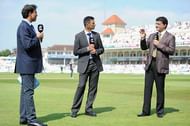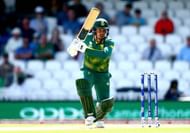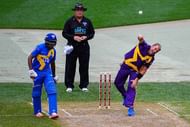
Cricket broadcasting is a tricky art. The number of parameters in cricket is unparalleled in any other sport and few sports have the action compartmentalised into balls, overs and innings as cricket does. This leaves broadcasters in a mire as to how to sift through the piles and piles of information: strike rates, pitch conditions, speed of bowler, release points, and so on and so forth, to display only relevant and interesting pieces while the game is in play, and in times between deliveries.
Furthermore, while cricket fields are big, the action is generally confined to the pitch, a relatively small area. How to focus the audience’s attention to those 22 yards, while still conveying the importance of the rest of the field is a real challenge.
Most broadcasters follow a uniform format today for all three formats, which came into being following Kerry Packer’s World Series Cricket, one the general public is not only used to, but also comfortable with.
However, this format has gaping flaws, ones that not only reduce the overall viewing experience for fans, but also the scope for analysis and even the attractiveness of cricket for new fans. This article delves into the ways in which cricket broadcasting could be improved, both during the match as well as before and after.
Displaying Field Settings
One of the most important aspects of the game is field position. Not only does it give key insights into what areas a bowler is trying to hit, but it also provides an understanding of a captain’s plans.
Yet, cricket broadcasters across the board do not display field settings at regular intervals. During a broadcast, commentators often allude to field changes, and these changes often define the flow of a game. But broadcasters fail to paint the whole picture through their reluctance to simply display the field regularly.
Cricket, because of its intricacies, is often met with scepticism from new fans, citing “not understanding” as a key reason for shying away from the game. Broadcasting the field placements is a simple solution to that. If someone knows where the fielders are, they understand what every player’s aim is, opening up a whole new world for them.
Changing the Press Conference
While it provides the occasional laugh, the cricket post-match press conference is redundant. A player, usually the captain, comes out to address the press, who largely ask the same, hackneyed, boring questions, game after game. TV audiences have little to no idea of what the question is, but the sporting clichés the players recite, half in exhaustion and political correctness, make for extremely boring viewing.
Consequently, every news outlet has the exact same, tired soundbites processed and published after games. Whether in a tabloid newspaper, or on a serious cricket website, the information remains the same, and avid fans, who have probably seen the press conference on TV, get no new information from news sources.
The press conference has been done away with in the NBA, where journalists are asked to go and get their own sound bites, either from the dressing room itself or on the court. Not only does this make the process a lot more personal, but fans are exposed to the raw emotions of a variety of different players after a game.
Journalists choose the players they want to ask questions to, making for more intelligent, specific questions and answers and while people may regard this as an invasion of privacy, it is, at the end of the day, what the fans really want: to see their heroes as people, to understand what is going through their idols’ minds. Not only does it make for better news due to more specific questions, it also allows for a larger variety of articles due to a bigger pool of players giving sound bites.
In cricket, particularly in the sub-continent, players often fall into “superstar syndrome”, and a leading cause is that massive attention is given to one or two players in a team, often ones who are predominantly in the public eye. Dividing the press’ attention to all members of a team’s dressing room can only help in sharing the public adulation amongst the entire team.
Furthermore, T20 cricket, particularly the Big Bash, has allowed presenters to speak to players and coaches in the dugout during slow periods in a game, something that can add value to Test and one-day international cricket. This would give audiences the chance to hear a captain’s strategy during the game, drumming up interest, while not diminishing the class of the product.
More journalists as commentators

Cricket commentary, particularly in India, has reached new lows in recent times. Not only have the BCCI censored all commentary, with the threat of exile, the quality of the content itself is usually very poor.
With respect to classic cricket commentary, one usually thinks of Richie Benaud, Tony Cozier, and Harsha Bhogle. The gravitas with which they brought the game to life was unparalleled. They knew how to make a boring passage of play interesting with valid stories and how to do justice to a thrilling contest without screaming into a microphone.
Those days are gone. Nowadays, commentary, with a few exceptions, is completely overrun by ex-players, all of whom have either a political directive (in the case of Ravi Shastri and Sunil Gavaskar, who are directly hired as BCCI spokesmen), or are inexperienced in the role and have too many ties in current world cricket to be objective third eyes, like Michael Clarke.
Often, commentators are simply not well trained, not knowledgeable enough and engage in tired and awkward chit-chat that is either extremely partisan, vague or simply irrelevant. Commentary nowadays targets the stupid fan, spelling out what has just happened, talking in fear of silence.
Commentary desperately needs an injection of professional journalists, podcasters, analysts or even presenters like Mark Howard, who stimulate interesting conversation. Having former players does enhance things by way of interesting cricket stories and expert analysis, but the players need to be fluent in the language they are commentating in, well-trained and experienced, without having conflicts of interest. Ian Chappel, Richie Benaud and Ian Bishop are notable examples of this.
Essentially, a balance must be reached. The three-person commentary team can contain one or two experts, who are ex-players, but it must also have a minimum of one career journalist, historian or presenter, to give cricket broadcasting the class it deserves.
Show more about players’ bats
In football, if a player wears a pair of new studs, it’s headline news. Kids and teenagers run screaming to their parents, begging them for extraordinary sums of money to buy that exact same pair of cleats. Cricket, a sport wherein equipment is exponentially more important, does not see this trend.
We know very little about the players’ key weapon of destruction: the bat. While Virat Kohli and AB de Villiers emblazon the proud MRF logo on their willows, little is known about the weight of their bats, their sweet spot, their maker, their shape and their profile. A player’s bat can define their game, and often, a bat can be the difference between a mishit to long-on and clearing the rope.
Yet, the TV audience is kept in the dark. GM, Kookaburra, Gray-Nicholls, SS and SG have been fine contributors to the game for decades, yet their names are shrouded to the confines of cricket stores and the recesses of the internet.
It’s simple logic. The public wants to know about players’ bats, especially in the shortest format, where innovative shapes, sizes and types of bats are being manufactured to send the ball those few extra meters. It is a giant cash cow. The increase in sponsorships and endorsements alone would be enough to convince broadcasters to display the name and a few key details about the bats used by cricketers.
Including some interesting stats
Cricket has always been a slow game to adapt. A batsman’s ‘time in the middle’ is still measured, despite having lost relevance in the shorter formats. However, sometimes, we see a glimpse of hope, of cricket embracing the 21st century when we see the use of high-speed cameras to provide the viewing audience with stats.
We see broadcasters show the time a player has to react for a catch, or the time it took to run a batsman out. These instances put the game into context for the layman, showing the intensity a passage of play really has in cricket.
Showing the time taken for running tight runs, fielding in the outfield, wicketkeeper and close-in catching and facing a ball will make the game get the cutting edge that its broadcast has often lost. Furthermore, it would help analysts gain key insights as cricket immerses itself into the data revolution.
Some other interesting stats could be: the number of kilometers travelled in a day of play by various players, length of run-ups, distance travelled to stop a boundary and number of revolutions on the ball for spinners, a stat that is used sometimes in Sky Sports broadcast, but needs to become a staple for spinners, as this is as important as the speed they bowl at.
Another interesting metric would be fielding metrics, which are being developed by various statisticians, which would add a whole new dimension to the analysis conducted on air, and enhance the viewing experience of TV audiences.
Miscellaneous improvements
#1 Displaying a timer to show how much time is remaining to review a decision, creating suspense and excitement among viewers.
#2 Standardising distances to the metric system, because talking in yards, feet and inches is confusing to most listeners outside England.
#3 Displaying crowd numbers at the peak of a match, and showing a pie chart of how much the crowd favours each team.
#4 Increasing the volume of the stump mic, to make what the players say audible, as sledging is a big part of the game.
These improvements would mean a bigger TV audience, bringing more money into the game, while still not compensating on the quality of the broadcast. They would lead to more fan engagement and less passive watching whilst still making it easily understandable for the new fan.
Cricket, as I said before, evolves very slowly, and its broadcast is no different. While new technology has been introduced, the same style has persisted for decades. Not only does this not stimulate the growth of the game, it is actively contributing to its downfall, and to be able to compete in a market of high-action, high-energy sports, it is high time that cricket broadcasting got with the times.
Follow IPL Auction 2025 Live Updates, News & Biddings at Sportskeeda. Get the fastest updates on Mega-Auction and cricket news



